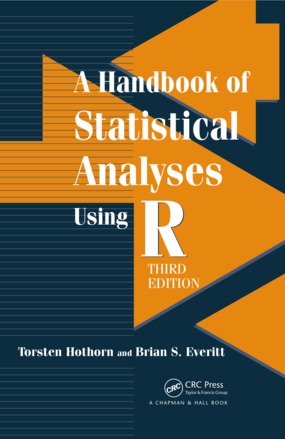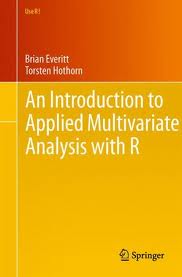Books
The R Series
Torsten Hothorn serves as one of the editors of CRC's The R Series.
A Handbook of Statistics Analyses Using R (3rd Edition)
by Torsten Hothorn and Brian S. Everitt
- New chapters on quantile regression, Bayesian inference, and missing values
- Updated material in many chapters
- Shows how to obtain informative graphical output using R
- Provides R code so readers can perform their own analyses
- Emphasizes the practical application and interpretation of results rather than focusing on the theory behind the analyses
- Offers an introduction to R, including a summary of its most important features
- Contains many examples and exercises
A Handbook of Statistics Analyses Using R (2nd Edition)
by Brian S. Everitt and Torsten Hothorn
- Shows how to obtain informative graphical output using R
- Provides R code so readers can perform their own analyses
- Emphasizes the practical application and interpretation of results rather than focusing on the theory behind the analyses
- Offers an introduction to R, including a summary of its most important features
- Contains many examples and exercises
An Introduction to Applied Multivariate Analysis with R
by Brian S. Everitt and Torsten HothornThe majority of data sets collected by researchers in all disciplines are multivariate, meaning that several measurements, observations, or recordings are taken on each of the units in the data set. These units might be human subjects, archaeological artifacts, countries, or a vast variety of other things. In a few cases, it may be sensible to isolate each variable and study it separately, but in most instances all the variables need to be examined simultaneously in order to fully grasp the structure and key features of the data. For this purpose, one or another method of multivariate analysis might be helpful, and it is with such methods that this book is largely concerned. Multivariate analysis includes methods both for describing and exploring such data and for making formal inferences about them. The aim of all the techniques is, in general sense, to display or extract the signal in the data in the presence of noise and to find out what the data show us in the midst of their apparent chaos. An Introduction to Applied Multivariate Analysis with R explores the correct application of these methods so as to extract as much information as possible from the data at hand, particularly as some type of graphical representation, via the R software. Throughout the book, the authors give many examples of R code used to apply the multivariate techniques to multivariate data.
Review: DOI 10.1111/j.1751-5823.2012.00187_11.x
Multiple Comparisons Using R
by Frank Bretz, Torsten Hothorn and Peter WestfallAdopting a unifying theme based on maximum statistics, Multiple Comparisons Using R describes the common underlying theory of multiple comparison procedures through numerous examples. It also presents a detailed description of available software implementations in R. After giving examples of multiplicity problems, the book covers general concepts and basic multiple comparisons procedures, including the Bonferroni method and Simes’ test. It then shows how to perform parametric multiple comparisons in standard linear models and general parametric models. It also introduces the multcomp package in R, which offers a convenient interface to perform multiple comparisons in a general context. Following this theoretical framework, the book explores applications involving the Dunnett test, Tukey all pairwise comparisons, and general multiple contrast tests for standard regression models, mixed-effects models, and parametric survival models. The last chapter reviews other multiple comparison procedures, such as resampling-based procedures, methods for group sequential or adaptive designs, and the combination of multiple comparison procedures with modeling techniques. Controlling multiplicity in experiments ensures better decision making and safeguards against false claims. A self-contained introduction to multiple comparison procedures, this book offers strategies for constructing the procedures and illustrates the framework for multiple hypotheses testing in general parametric models. It is suitable for readers with R experience but limited knowledge of multiple comparison procedures and vice versa.



